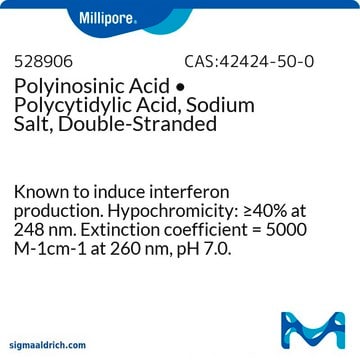P9528
Polyuridylic acid potassium salt
Synonym(s):
Poly(U) potassium salt
About This Item
Recommended Products
assay
≥98% (TLC)
Quality Level
form
lyophilized powder
solubility
water: 19.60-20.40 mg/mL, clear to slightly hazy, colorless
storage temp.
−20°C
InChI
1S/C9H13N2O9P/c12-5-1-2-11(9(15)10-5)8-7(14)6(13)4(20-8)3-19-21(16,17)18/h1-2,4,6-8,13-14H,3H2,(H,10,12,15)(H2,16,17,18)/t4-,6-,7-,8-/m1/s1
InChI key
DJJCXFVJDGTHFX-XVFCMESISA-N
Looking for similar products? Visit Product Comparison Guide
Application
Preparation Note
Storage Class
11 - Combustible Solids
wgk_germany
WGK 3
flash_point_f
Not applicable
flash_point_c
Not applicable
Certificates of Analysis (COA)
Search for Certificates of Analysis (COA) by entering the products Lot/Batch Number. Lot and Batch Numbers can be found on a product’s label following the words ‘Lot’ or ‘Batch’.
Already Own This Product?
Find documentation for the products that you have recently purchased in the Document Library.
Customers Also Viewed
Our team of scientists has experience in all areas of research including Life Science, Material Science, Chemical Synthesis, Chromatography, Analytical and many others.
Contact Technical Service










